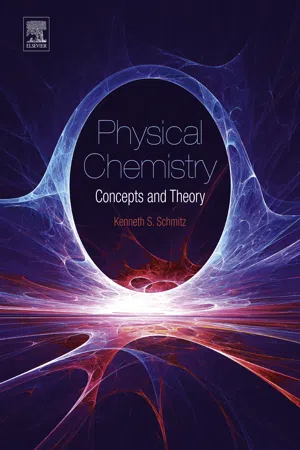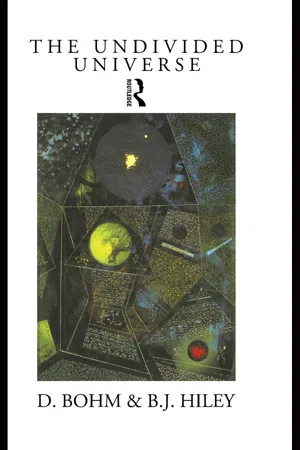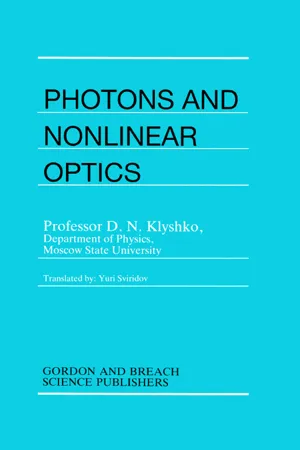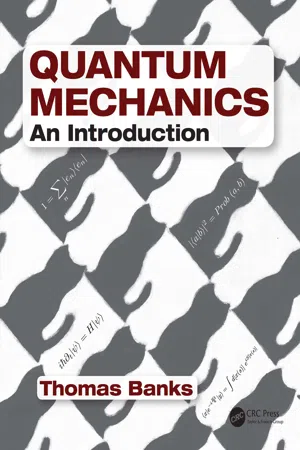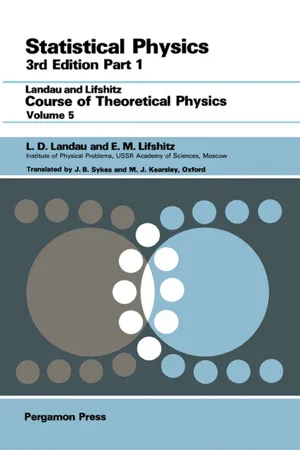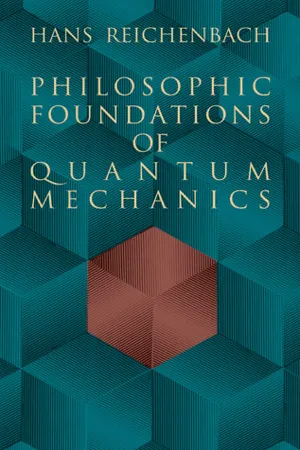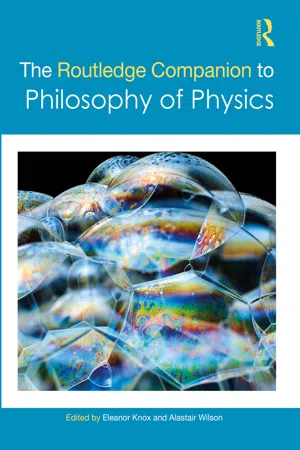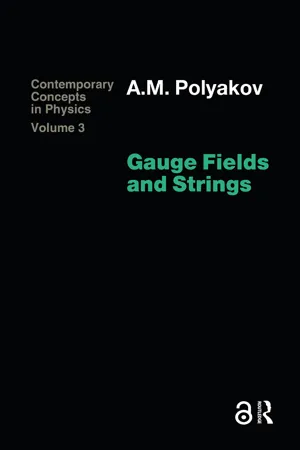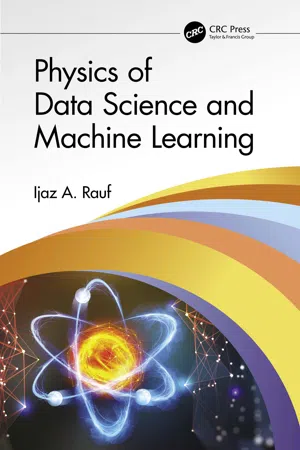Physics
Statistical Quantum Mechanics
Statistical quantum mechanics is a branch of quantum mechanics that deals with the statistical behavior of large ensembles of quantum systems. It provides a framework for understanding the probabilistic nature of quantum phenomena, incorporating concepts from both quantum mechanics and statistical mechanics. This approach is essential for describing complex systems in which individual quantum states are not well-defined.
Written by Perlego with AI-assistance
Related key terms
Related key terms
1 of 4
Related key terms
1 of 3
9 Key excerpts on "Statistical Quantum Mechanics"
- eBook - ePub
Physical Chemistry
Concepts and Theory
- Kenneth S Schmitz(Author)
- 2016(Publication Date)
- Elsevier(Publisher)
Chapter 13Quantum Statistical Mechanics
Abstract
Classical statistical mechanics and quantum statistical mechanics are both based on the statistical probability description of Nature. Classical statistical mechanics applies to a statistically significant number of particles, the bridge between the properties of individual particles and the bulk properties of a system. Temperature and pressure have no meaning if there is only one gas particle in a balloon. Quantum statistical mechanics is the study of probability potentials of individual particles as well as bulk properties. In both areas of statistical mechanics the correct counting of the degeneracy of states cannot be understated. The states of a pair of electrons and a pair of dice are compared to illustrate problems associated with the degeneracy of states.The distinguishing feature of quantum theory that has no classical counterpart is superposition of wave functions. The manner in which wave functions of particles with integer spin (Bose–Einstein particles) and half-integer spin (Fermi–Dirac particles) can be superimposed, and quantum states filled greatly affect the degeneracy of quantum states. Under conditions that the de Broglie wavelength (or thermal wavelength) exhibits substantial overlap, the differences in the statistical nature of Bose–Einstein and Fermi–Dirac particles are amplified.The grand partition function and weighting factors for Maxwell–Boltzmann, Bose–Einstein, and Fermi–Dirac particles are compared. Bose–Einstein condensation and the lambda transition for helium-4 are examined, and overcounting of states is quantitatively examined with the Scatchard model for binding on a linear lattice.Keywords
Bose–Einstein condensation; Bose–Einstein statistics; Bosons; Degeneracy of states; Dice as an analogue to quantum states and degeneracy; Exchange of particles; Fermi–Dirac statistics; Fermions; Lambda transition; Maxwell–Boltzmann statistics13.0. Introduction
- eBook - ePub
The Undivided Universe
An Ontological Interpretation of Quantum Theory
- David Bohm, Basil J. Hiley(Authors)
- 2006(Publication Date)
- Routledge(Publisher)
4 ].) However, in this book it is not our main purpose to discuss quantum statistical mechanics, but rather to focus on the fact that an ontological interpretation of the basic quantum theory is possible. What we have done in this section is to show the general lines along which one can include quantum statistical mechanics within the framework of our approach.9.5 The stochastic explanation of quantum probabilities
We have thus far been explaining quantum probabilities in terms of chaotic motions that are implied by the quantum laws themselves, with pure ensembles representing chaotic motions of the particles and mixed ensembles bringing in also chaotic variations in the quantum field. Whenever we have statistical distributions of this kind, however, it is always possible that these chaotic motions do not originate in the level under investigation, but rather that they arise from some deeper level. For example, in Brownian motion, small bodies which may contain many molecules undergo chaotic velocity fluctuations as a result of impacts originating at a finer molecular level. If we abstract these chaotic motions and consider them apart from their possible causes we have what is called a stochastic process which is treated in terms of a well-defined mathematical theory [5 ]. We can have two attitudes to such a stochastic process. The first is that it is a result of deeper causes that do not appear at the level under discussion. The second is that there is some intrinsic randomness in the basic motions themselves. In so far as we apply the ordinary mathematical treatment, we need not commit ourselves to either attitude. But of course, if we are thinking of possible models for the process then our attitude may make a difference, because the assumption of deeper causes implies that the stochastic treatment will break down at the finer level at which these causes are operating. (We shall discuss this possibility in chapter 14 - eBook - ePub
- D.N. Klyshko(Author)
- 2018(Publication Date)
- Routledge(Publisher)
2 Some Information on Quantum Mechanics and Statistical PhysicsTHIS CHAPTER provides a brief summary of some of the basic concepts and formal rules used in quantum mechanics and statistics that we shall need later to describe the radiation of light and its scattering by matter. Section 2.1 contains a recipe for passing from the classical equations of motion to quantum equations. It also discusses the relation between observed and calculated quantities. Section 2.2 introduces the convenient Dirac notation and a geometric interpretation of quantum mechanics. Section 2.3 examines the interaction representation and the theory of perturbation. Section 2.4 deals with an important law of statistical physics known as the fluctuation-dissipation theorem (FDT). Finally, Section 2.5 introduces the notions of relaxation and the thermostat and derives the simplest kinetic equation, which differs from dynamic equations in that it allows for an interaction with the thermostat. This interaction leads to damping and thermal noises, which are added to the quantum noises when T ≠ 0.2.1 Passing from a Classical Description to a Quantum Description The Quantization of the Equations of Motion Let us assume that the classical equations of motion of the system of interest are known to us. For instance, the classical dynamics of a one-dimensional linear oscillator obeys Newton’s second law:
The procedure for passing to quantum dynamics includes the following four basic stages:mq= − k q + F· ·( t ).(1) 1) The choice of the most convenient system of coordinates {qi (t)}, which, together with the velocities{determine the state of the system, i.e., provide complete information on it.( t ) }q i.2) The selection of that Lagrange’s functionLwhich, given the use of the system of Lagrange’s equations(q ,)q ., tdd t−∂ L∂q ˙i= 0 ,∂ L∂q i(2) leads to the initial equations of motion. Thus, it can readily be verified that (1) - eBook - ePub
Quantum Mechanics
An Introduction
- Thomas Banks(Author)
- 2018(Publication Date)
- CRC Press(Publisher)
Chapter 12Quantum Statistical Mechanics
12.1 Introduction
The key difference between classical and quantum statistical mechanics of particles has to do with identity of particles. In both classical and quantum mechanics (QM), one can write a Hamiltonian for an N particle system, which has an S N permutation symmetry exchanging the particles. In both cases, we can consider states that are invariant under the symmetry, as well as states that are not. There is no fundamental principle, enunciated in our description of QM, which requires us to reject states that are not invariant under the symmetry group. Rather, the experimental facts of the world we live in require this rejection.The first indication of this was found by Gibbs, in his discussion of the entropy of mixing between two boxes of gas. If a partition is removed between two boxes containing different gases, then an elementary calculation shows that the entropy increases. There are more states available. However, if we treat the molecules of a single gas as distinguishable particles, which is to say particles whose states1 need not be symmetric, even though the Hamiltonian is, then exactly the same calculation shows that the entropy increases when we remove a partition between two identical boxes of gas. This does not agree with experimental observations on the thermodynamics of uniform gases.The solution, in both classical and quantum mechanics, is to view particles as localized excitations of fields. In this interpretation, fields are fundamental, particles are special states of such fields, and the identity of particle states under permutation is a consequence of the fact that permutation of the particles gives the same field configuration. The details of how this works in classical and quantum mechanics are quite different. In classical mechanics, particle-like behavior implies that the state is eternally localized in space, and only special nonlinear field equations have such soliton solutions. In QM, however, we have seen that eigenstates of the quantized field Hamiltonian, for linear field theories, have a particle interpretation. The field is an operator which adds or subtracts a particle to/from the system and the field configuration associated with a particle is interpreted as the matrix element of the fieldϕs(x ) = ⟨0|ϕ (x )|s 〉 between the state |0〉 with no particles and a single particle state |s 〉. For linear field theories, this is equal to the single particle wave function of the particle state, and the spreading of wave packets is understandable in terms of the fact that free particle states are not localized eternally, because of the Heisenberg uncertainty relations.ϕs(x ) cannot be interpreted as a classical observable of the system. By contrast, coherent states, which are superpositions of states with different particle numbers, DO behave classically in the fully quantized theory.2 - eBook - ePub
- L. D. Landau, E. M. Lifshitz(Authors)
- 2013(Publication Date)
- Pergamon(Publisher)
(5.4) has a twofold nature. It comprises both the averaging due to the probabilistic nature of the quantum description (even when as complete as possible) and the statistical averaging necessitated by the incompleteness of our information concerning the object considered. For a pure state only the first averaging remains, but in statistical cases both types of averaging are always present. It must be borne in mind, however, that these constituents cannot be separated; the whole averaging procedure is carried out as a single operation, and cannot be represented as the result of successive averagings, one purely quantum-mechanical and the other purely statistical.The statistical matrix in quantum statistics takes the place of the distribution function in classical statistics. The whole of the discussion in the previous sections concerning classical statistics and the, in practice, deterministic nature of its predictions applies entirely to quantum statistics also. The proof given in § 2 that the relative fluctuations of additive physical quantities tend to zero as the number of particles increases made no use of any specific properties of classical mechanics, and so remains entirely valid in the quantum case. We can therefore again assert that macroscopic quantities remain practically equal to their mean values.In classical statistics the distribution function (p , q ) gives directly the probability distribution of the various values of the coordinates and momenta of the particles of the body. In quantum statistics this is no longer true; the quantitieswngive only the probabilities of finding the body in a particular quantum state, with no direct indication of the values of the coordinates and momenta of the particles.From the very nature of quantum mechanics, the statistics based on it can deal only with the determination of the probability distribution for the coordinates and momenta separately, not together, since the coordinates and momenta of a particle cannot simultaneously have definite values. The required probability distributions must reflect both the statistical uncertainty and the uncertainty inherent in the quantum-mechanical description. To find these distributions, we repeat the arguments given above. We first assume that the body is in a pure quantum state with the wave function (5.1) - eBook - ePub
- Hans Reichenbach(Author)
- 2012(Publication Date)
- Dover Publications(Publisher)
Part IIIINTERPRETATIONS
§24. Comparison of Classical and Quantum Mechanical Statistics
In Part II we have explained the mathematical methods by which quantum mechanics derives the probability distributions of physical entities. We now shall turn to a logical analysis of these methods.In classical physics a situation is determined if the parameters q 1 ... q n and p 1 ... p n are given. Let us write, as before, q for q 1 ... q n , and p for p 1 ... p n . Values at the time t 0 are indicated by the subscript o. We then can summarize the derivative relations of classical physics in the following table:Given:- 1) the values of q 0 and p 0 at a time t 0
- 2) the physical laws
- 3) the value u 0 of every other entity concerned at the time t 0
- 4) the values q t and p t of q and p at a time t
- 5) the value u t of any entity u at a time t
The derivation of the values 3–5 is achieved by means of the following mathematical functions, in which we use the symbol f to indicate a function in general, without specification of its individual form:(1)(2)(3)These relations constitute the causal laws of the problem.Now let us consider a generalization which may be called classical-statistical physics, and which consists in a combination of causal laws with statistical methods. In this case we consider the causal laws (1)-(3) as still valid; we introduce, however, a method which takes into account the fact that the values q 0 and p 0 cannot be exactly measured. The specification of these values is therefore replaced by the statement of their probability distributions. We write these distributions at the time to in the form d 0 (q ), d 0 (p ), and d 0 (q,p ), the latter function giving the probability of combinations of values q and p. The table of derivative relations of classical-statistical physics - eBook - ePub
- Eleanor Knox, Alastair Wilson, Eleanor Knox, Alastair Wilson(Authors)
- 2021(Publication Date)
- Routledge(Publisher)
Wallace, 2013 ). I now turn to describe various approaches to quantum statistical mechanics that are offered in the literature.To describe the different approaches to quantum statistical mechanics it is useful to distinguish between two kinds of regularities that are addressed by thermodynamics: One kind involves synchronic functional relations , especially those that hold in equilibrium, such as the ideal gas law, and the other involves diachronic relations , especially the approach to equilibrium and the second law of thermodynamics (for the distinction between the two latter ones see Brown and Uffink, 2001 ). In this section, I focus on synchronic relations and discuss the diachronic ones in the next section.In classical statistical mechanics there are two main theories concerning synchronic functional relations, usually referred to as stemming from the works of Boltzmann and of Gibbs (see the chapters by Frigg and Werndl in this volume and references therein). In the Boltzmannian theory, the measured magnitudes are understood as macrovariables, that is, as aspects of the microstates that obtain during a measurement. In the Gibbsian theory, measured magnitudes are understood as weighted functions over the entire phase space. (For conceptual problems with the latter theory see Callender, 1999 , Wallace, 2013 ; for an approach that combines both theories and thus accounts for both, see Lavis, 2005 , 2008 ; Hemmo and Shenker, 2012 , Chapter 11 ). In quantum statistical mechanics there are two corresponding views. The first view (called “individualist” by Goldstein and Tumulka, 2011 ) states that a system has a given thermodynamic property if it is either in a pure state with high amplitudes for eigenvalues corresponding to that thermodynamic property, or in a reduced state that entails a high probability for the corresponding thermodynamic observations (see Linden et al., 2009 ; Goldstein et al., 2016 , and references in both). The second view (called “ensemblist” in Goldstein and Tumulka, 2011 ) states that a system has a given thermodynamic property if it is in an appropriate statistical state, given by a density matrix, which entails a certain expectation value. Perhaps Von Neumann’s concept of thermal equilibrium is ensemblist (see Goldstein and Tumulka, 2011 ; Goldstein et al., 2010 ; Goldstein et al., 2016 , Section 9.2 ), and Emch (2007 ) seems to follow this line as well. The conceptual problems in the classical Gibbsian approach carry over to the quantum mechanical domain, mutatis mutandis (see Wallace, 2001 , 2013 - eBook - ePub
- A. M. Polyakov(Author)
- 2018(Publication Date)
- Routledge(Publisher)
CHAPTER 1Statistical Mechanics and Quantum Field Theory
DOI: 10.1201/9780203755082-11.1 Quantum Particles
We have no better way of describing elementary particles than quantum field theory. A quantum field in general is an assembly of an infinite number of interacting harmonic oscillators. Excitations of such oscillators are associated with particles. The special importance of the harmonic oscillator follows from the fact that its excitation spectrum is additive, i.e. if E1 and E2 are energy levels above the ground state then E1 + E2 will be an energy level as well. It is precisely this property that we expect to be true for a system of elementary particles. Therefore we attempt to identify the Hamiltonian of the particles with the Hamiltonian of coupled oscillators (there is a familiar example from solid state physics: the excitations of a crystal lattice can be interpreted as particles—phonons). All this has the flavour of the XIX century, when people tried to construct mechanical models for all phenomena. I see nothing wrong with it because any nontrivial idea is in a certain sense correct. The garbage of the past often becomes the treasure of the present (and vice versa). For this reason we shall boldly investigate all possible analogies together with our main problem.A very important analogy, which will be extensively used below, is the one between the quantum mechanics of a D-dimensional system and the classical statistical mechanics of a D + 1-dimensional system. Let us demonstrate it in the simplest case of the D = 1 quantum mechanics of one particle. According to the Feynman principle, the transition amplitude F from the point x to the point x′ is given by the sum over all possible trajectories connecting points x and x′, each trajectory entering with the weight exp((i/ℏ)S[x(t)]) where S[x(t - eBook - ePub
- Ijaz A. Rauf(Author)
- 2021(Publication Date)
- CRC Press(Publisher)
CHAPTER 3 An Overview of Quantum MechanicsDOI: 10.1201/9781003206743-3Classical mechanics have been continuously developed since Newton’s time and applied to an ever-widening variety of complex systems, including interaction with matter and the electromagnetic field. The philosophy of minimal action governs classical mechanics. When scientists first observed the behavior of electrons and nuclei, they tried to explain their experimental results in terms of Newtonian classical motions, but, in the end, these attempts failed. We find that these small particles behaved in a way that is not in line with Newton’s equations.The classical measurement theory assumes that an interaction between the system of interest and the measuring device can be made arbitrarily small or accurately compensated. One may talk of an idealized measurement that does not interrupt the system’s properties of interest. Nevertheless, in the case of an atomic phenomenon, the interaction between the system and measuring instrument is not arbitrarily minimal. Nor can the interaction-related disruption be accounted for precisely because it is uncontrollable and unpredictable to some degree. A calculation on one property will also result in irreversible changes in the value previously allocated to another feature. To talk of a microscopic system with exact amounts for all its wealth is meaningless. Therefore, atomic physics laws must be represented in a nonclassical language, which is a symbolic representation of microscopic measurement principles.Let us now consider some experimental data that gave rise to these paradoxes and led to quantum mechanics development. Light exhibiting interference was assumed to be a wave phenomenon; however, later, it was observed that shining light on a metal surface results in electrons’ ejection from the metal surface (photoelectric effect). Considering the photoelectric effect based on the wave nature of light would conclude that the ejected electron’s energy would depend on the intensity of light rather than the frequency observed in experiments.
Index pages curate the most relevant extracts from our library of academic textbooks. They’ve been created using an in-house natural language model (NLM), each adding context and meaning to key research topics.
Explore more topic indexes
Explore more topic indexes
1 of 6
Explore more topic indexes
1 of 4
